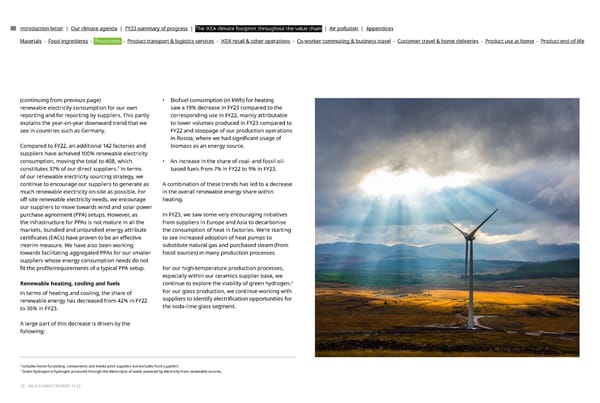Introduction letter | Our climate agenda | FY23 summary of progress | The IKEA climate footprint throughout the value chain | Air pollution | Appendices Materials - Food ingredients - Production - Product transport & logistics services - IKEA retail & other operations - Co-worker commuting & business travel - Customer travel & home deliveries - Product use at home - Product end-of-life • Biofuel consumption (in kWh) for heating (continuing from previous page) renewable electricity consumption for our own saw a 19% decrease in FY23 compared to the reporting and for reporting by suppliers. This partly corresponding use in FY22, mainly attributable explains the year-on-year downward trend that we to lower volumes produced in FY23 compared to see in countries such as Germany. FY22 and stoppage of our production operations in Russia, where we had signi昀椀cant usage of Compared to FY22, an additional 142 factories and biomass as an energy source. suppliers have achieved 100% renewable electricity consumption, moving the total to 408, which • An increase in the share of coal- and fossil oil- constitutes 37% of our direct suppliers.¹ In terms based fuels from 7% in FY22 to 9% in FY23. of our renewable electricity sourcing strategy, we continue to encourage our suppliers to generate as A combination of these trends has led to a decrease much renewable electricity on-site as possible. For in the overall renewable energy share within heating. o昀昀-site renewable electricity needs, we encourage our suppliers to move towards wind and solar power In FY23, we saw some very encouraging initiatives purchase agreement (PPA) setups. However, as the infrastructure for PPAs is not mature in all the from suppliers in Europe and Asia to decarbonise markets, bundled and unbundled energy attribute the consumption of heat in factories. We’re starting to see increased adoption of heat pumps to certi昀椀cates (EACs) have proven to be an e昀昀ective interim measure. We have also been working substitute natural gas and purchased steam (from towards facilitating aggregated PPAs for our smaller fossil sources) in many production processes. suppliers whose energy consumption needs do not For our high-temperature production processes, 昀椀t the pro昀椀le/requirements of a typical PPA setup. especially within our ceramics supplier base, we 2 Renewable heating, cooling and fuels continue to explore the viability of green hydrogen. In terms of heating and cooling, the share of For our glass production, we continue working with renewable energy has decreased from 42% in FY22 suppliers to identify electri昀椀cation opportunities for to 36% in FY23. the soda-lime glass segment. A large part of this decrease is driven by the following: 1 Includes home furnishing, components and media print suppliers but excludes food suppliers. 2 Green hydrogen is hydrogen produced through the electrolysis of water powered by electricity from renewable sources. 20 - IKEA CLIMATE REPORT FY23
 IKEA CLIMATE Report FY23 Page 19 Page 21
IKEA CLIMATE Report FY23 Page 19 Page 21